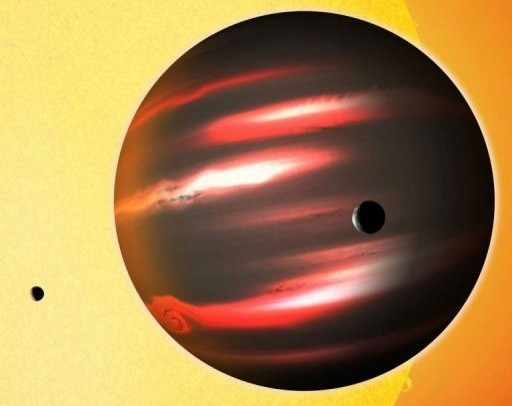Darkest Alien Planet Blacker than Coal Discovered [PHOTOS]

Astronomers have discovered the darkest alien planet known to existence in the galaxy, described as being blacker than coal with a subtle red hue.
The Jupiter-sized gas giant named TrES-2b was found using NASA's Kepler spacecraft, which has the capacity to measure light, even in extremely distant objects. However, TrES-2b reflects less than one percent of light shined upon it, making it the darkest planet or moon ever discovered thus far.
"TrES-2b is considerably less reflective than black acrylic paint, so it's truly an alien world," said lead author and astronomer David Kipping of the Harvard-Smithsonian Center for Astrophysics (CfA).
TrES-2b is heated up to temperatures greater than 1,800 degrees Fahrenheit by its star, which it orbits from a mere distance of 3 million miles. This planet is unique as it does not have any clouds similar to planets like Jupiter, cloaked by clouds of ammonia. Rather, high temperatures prohibit any clouds from forming, causing a mystery as to why the planet is so dark and unreflective.
"It's not clear what is responsible for making this planet so extraordinarily dark," co-author David Spiegel of Princeton University said. "However, it's not completely pitch black. It's so hot that it emits a faint red glow, much like a burning ember or the coils on an electric stove."
While it is not clear why the planet is so dark, astronomers have found that the atmosphere of TrES-2b does contain chemicals like vaporized sodium and potassium and titanium oxide, all of which absorb light. The team of astronomers is uncertain if these chemicals are the reason for the intensity of darkness found on the planet.
TrES-2b orbits with one side always facing its star, GSC 03549-02811, and has changing phases that causes a dimming effect. Kepler monitored the brightness of the planet using photometers that sense and monitor light during its changing phases and noticed a faint dimming and brightening variety.
"We detected the smallest-ever change in brightness from an exoplanet: just 6 parts per million," said Kipping. "In other words, Kepler was able to directly detect visible light coming from the planet itself."
While Jupiter-like planets are expected to be dark, the intensity of darkness on TrES-2b, located 750 light years away from Earth, is unique to the solar system.
"This represents the smallest photometric signal we have ever detected from an exoplanet," Kipping said in a statement to National Geographic, comparing the same ratio of dimming as a fruit fly would in front of a car headlight.
© Copyright IBTimes 2025. All rights reserved.





















